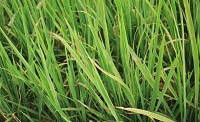Isolation and Characterization of Xanthomonas oryzae isolates from different regions of Midnapore district of West Bengal and their Ecofriendly management by some medicinal plant extracts
Keywords:
BLB, Xanthomonas oryzae, Citrus limon, Adhatoda vasicaAbstract
The potential of indigenous medicinal plants as alternative chemical pesticides for controlling bacterial leaf blight (BLB) of rice was tested in the present study. Infected plant samples were collected from five different fields of Purba and Paschim Medinipur, West Bengal. The obtained isolates were subjected to biochemical tests which showed similar results. Xanthomonas oryzae pv. Oryzae, the causal agent of the bacterial leaf blight of rice was characterized through different biochemical tests and assays. Isolates gave dome shaped, yellow colonies on nutrient agar (NA) plates. Gram staining showed that the pathogen is Gram negative and rod shaped, also potassium hydroxide (KOH) test was performed in order to support the results of Gram staining. Endospore staining showed that the isolated pathogen is a non-spore forming bacterium. Starch hydrolysis test, egg yolk reaction, gelatin hydrolysis test and oxidase test gave negative results against the pathogen. Four different and easily available medicinal plant species such as Adhatoda vasica, Lantana camera, Allium sativum and Citrus limon were screened for antibacterial activity against the isolated pathogen. Based on the biochemical responses and also the activity against different plant extracts, it may be concluded that the causal agent is the same for the bacterial leaf blight of rice in the chosen fields of Purba and Paschim Medinipur and there is no significant difference between the pathogenicity and activity of the isolates from the different fields put to test.
References
Amadioha AC, 2000. Controlling rice blast in vitro and in vivo with extracts of Azadirachta indica. Crop Protect., 19: 287-290.
Anonymous 2009a. Economic Survey, Agriculture and Food Management. http:// India.nic.in
Anonymous 2009b. Economic Survey, Agriculture and Food Management. http:// India.nic.in
Ansari MM, 1995. Control of sheath blight of rice by plant extracts. Indian Phytopathol., 48: 268-270.
Ghasemie, E., Kazempour, M. N. and Ferydon, P. 2008. Isolation and Identification of Xanthomonas oryzae pv. Oryzae the causal agent of bacterial blight of rice in Iran. J. plant protection research. 48(1):53-62.
Guyer, D., Tuttle, A. S., Johnson, M., Potter, S., Gorlach, J., Forff, S. and land, C. L. 1998. Activation of latent transgenes in Arabidopsis using a hybrid transcription factor. Genetics. 149: 633-639.
Kagale S., Marimuthu T., Thayumanavan B., Nandakumar R., Samiyappan R., 2004. Antimicrobial activity and induction of systemic resistance in rice by leaf extract of Datura metel against Rhizoctonia solani and Xanthomonas oryzae pv. oryzae. Phys. Mol. Plant Pathol., 65: 91-100.
Klement, A. and R. Goodman 1967. The hypersensitivity reaction to infection by bacterial plant pathogens. Annual Review of Phytopathology, 5:17-44.
Kovaes, N. 1956. Identification of Preudomonas pyocyanea by the oxidase reaction. Nature, London, 178:703 pp.
Mason JR, Mathew DN, 1996. Evaluation of neem as a bird repellent chemical . Int. J. Pest Manage., 42: 47-49.
McClung, L. s. and R. Toabe. 1947. The Egg Yolk Plate Reaction for the Presumptive Diagnosis of Clostridium Sporogenes and Certain Species of Gangrene and Botulinum groups. J. Bacteriol. 53: 139-147.
McGee D. C., 1995. Epidemiology approach to disease management through seed, Technology. Ann. Rev. Phytopathol 33: 445-466.
Mew, T, W. 1987. Current status and future prospets of research on bacterial blight of rice. Annu. Rev. Phytopathol, 25: 359-382.
Narasimhan V, Selvam R, Mariappan V, 1995. In: Mariappan V, editor. Neem for the management of crop diseases. New Delhi: Associated Publishing Co., pp. 15-121.
Narwal S, Balasubrahmanyam A, Sadhna P, Kapoor H, Lodha ML, 2000. A systemic resistance inducing antiviral protein with N-glycosidase activity from Bougainvillea xbuttiana leaves. Indian J. Exp. Biol., 39: 600-603.
Ou, S. H.. 1985. Bacterial leaf blight in rice diseases. Common wealth Microbiological Institutes, Cambrian News, Aberystwyth, U. k. 70-74.
Paul PK, Sharma PD, 2002. Azadirachta indica leaf extract induces resistance in barley against leaf stripe disease. Phys. Mol. Plant Pathol., 61: 3-13.
Quasem JR, Abu-Blan HA, 1996. Fungicidal activity of some common weed extracts against different plant pathogenic fungi. J. Phytopathol., 144: 157-161.
Singh DC, 1994. Scope of medicinal and aromatic plants in pest management. International symposium, allelopathy in sustainable agriculture, forestry and environment, New Delhi, 6-8: 68.
Srivastava DN, rao YP, 1964. A single technique for detecting Xanthomonas oryzae in rice seeds. Seed Sci. Technol., 5: 123-127.
Suslow, T. W., N. Schrotl and M. Isaha. 1982. Application of a rapid method for Gram differentiation of plant pathogenic bacteria without staining. Phytopathology, 72:917-918.
Wilson, m. and S.E. Lindow 1993. Interaction between the biological control agent Pseudomons fluorescens A 506 and Ervinia amylovora in pear blossoms. Phytopathology, 83: 117-123.
Xue L, Charest PM, Jabaji-Hare SH, 1998. Systemic induction of peroxidases, β-1,3-glucanases, chitinases and resistance in bean plants by binucleate Rhizoctonia species. Phytopathol., 88: 359-365.



